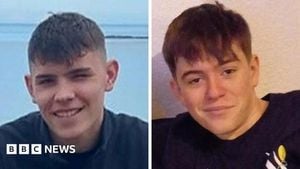Few films in recent memory have left audiences as shaken and contemplative as Zach Cregger’s 2025 horror masterpiece, Weapons. Praised as an instant classic by critics and moviegoers alike, the film’s chilling narrative and layered social commentary have sparked intense discussion, not just about its supernatural thrills, but about the real-world traumas it allegorizes. According to TheWrap, Weapons is being hailed as "one of the very best movies you’ll see this year," a rare accolade in the crowded horror genre.
From its opening scenes, Weapons establishes an atmosphere of creeping dread reminiscent of John Carpenter, while weaving a sprawling, multi-perspective story structure that echoes Paul Thomas Anderson’s best work. The film’s power, as noted by reviewers, comes from its slow, deliberate reveal of the truth behind a seemingly inexplicable tragedy: the disappearance of an entire classroom of children in the dead of night.
The story begins in the small town of Maybrook, where at exactly 2:17 a.m., every child from Miss Gandy’s class mysteriously rises from bed and slips out into the darkness, leaving their families in a state of panic and confusion. The only student who doesn’t vanish is Alex Tilly, a quiet boy living with his enigmatic "aunt" Gladys. As the town reels from the loss, a host of characters—Miss Gandy (played by Julia Garner), Archer Graff (Josh Brolin), the father of a missing boy, and Paul Morgan (Alden Ehrenreich), a local beat cop—begin to unravel the mystery, each from their own vantage point.
What follows is a tense and twisting investigation that expands to include Anthony, a local drug addict and vagabond. After breaking into Gladys’s house, Anthony stumbles upon the missing children, hidden away and seemingly under some unholy influence. He quickly alerts Morgan, but both men soon fall under the spell of Gladys herself, whose powers soon become terrifyingly clear.
The film’s supernatural premise is rooted in Gladys’s identity as a witch. According to TheWrap, Gladys orchestrated the children’s disappearance as part of a ritual designed to drain their life force, thereby preserving her own existence. The ritual’s success depended on Alex, who was coerced into stealing an item from each of his classmates—a chilling detail that adds a layer of personal betrayal to the horror. Despite a thorough police investigation, the children remain hidden, concealed by Gladys’s cunning and occult abilities.
As the narrative hurtles forward, Miss Gandy and Graff conduct their own parallel investigation, eventually deducing that the children are being held in the Tilly house. Their rescue attempt, however, quickly devolves into chaos. Upon entering the house, they are ambushed by Morgan and Anthony, both now puppets of Gladys’s will. In a harrowing sequence, Miss Gandy is forced to kill Morgan—her former lover—while Graff nearly beats Anthony to death before Miss Gandy, seizing Morgan’s service weapon, shoots Anthony dead. The violence is sudden and brutal, underscoring the emotional toll the ordeal exacts on the community’s would-be saviors.
Yet the film’s most shocking turn is still to come. Young Alex, previously a pawn in his aunt’s scheme, turns the tables by using her own occult techniques to re-possess the children—not to harm them, but to weaponize them against Gladys. In a climactic, almost surreal sequence, the children rise as a vengeful horde, chasing Gladys through the neighborhood, smashing windows, and tearing through the homes of their once-peaceful community. The horror crescendos as the children finally corner Gladys and literally rip her apart, with one child gruesomely pulling half her head off. After this cathartic act of violence, the children abruptly fall into a catatonic state, their trauma rendered physically and emotionally manifest.
The aftermath is as bleak as any in modern horror. Graff finds his son among the survivors and walks away with him, but the reunion is far from joyous. The film’s young narrator, who guides viewers through the unfolding tragedy, offers a grim epilogue: "Most of the kids who ran away remained catatonic. But some started speaking again." There are no easy answers, no neat resolutions—only the lingering impact of trauma on those who remain.
What sets Weapons apart from typical genre fare is its willingness to grapple with real-world horrors through the lens of the supernatural. As TheWrap points out, the film serves as a potent allegory for school shootings and the enduring scars such tragedies leave on communities. By framing the children’s disappearance as the result of witchcraft and mystical conspiracies, Cregger satirizes what the film describes as "magical thinking"—the tendency, particularly in some conservative circles, to explain away mass violence with comforting fictions or to treat it as something that can be prayed away.
The film’s narrator explicitly highlights this theme, noting that the events in Maybrook have been "covered up and forgotten about in the years since—just like every major tragedy (which is always followed by another major tragedy)." This commentary is as much about the ways societies process collective trauma as it is about the specifics of the plot. The pain, suspicion, and loss, the film suggests, do not vanish with time; instead, they "seep into the ground, get into the water, and will be felt for decades to come." The trauma is not just immediate, but generational, haunting the community long after the headlines fade.
Stylistically, Weapons is a tour de force, blending moments of dark humor with sequences of almost unbearable tension. Director Zach Cregger, known for his previous work on Barbarian, brings a deft touch to both the film’s scares and its emotional beats. The performances—particularly from Garner, Brolin, and Ehrenreich—are raw and compelling, grounding the supernatural elements in genuine human emotion.
But perhaps the most haunting aspect of Weapons is its refusal to offer closure. Even as the immediate threat is vanquished, the community is left shattered, the children’s futures uncertain, and the adults forever marked by what they have witnessed and done. The film’s allegorical power lies in this ambiguity, forcing viewers to confront not only the horrors on screen, but the unresolved traumas lurking beneath the surface of everyday life.
In the end, Weapons stands as both a riveting horror film and a searing social commentary, a story that will linger in the minds of viewers—and perhaps in the collective conscience—for years to come.




